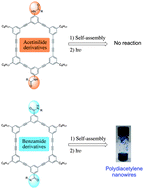The importance of the amide configuration in the gelation process and topochemical polymerization of phenylacetylene macrocycles†
Abstract
Two series of amide-containing phenylacetylene macrocycles (PAMs) were prepared and self-assembled through a gelation process in an organic solvent. Their gelation properties along with their molecular arrangements in the xerogel state, their morphological features and their reactivity toward the topochemical polymerization of the butadiyne units embedded within the structure were studied with respect to the amide configuration. The PAMs of series 1 with the nitrogen atom of the amide function directly attached to the phenyl groups of the PAMs (acetanilide derivatives) showed less organized molecular organization and less reactivity toward topochemical polymerization than the PAMs of series 2 with the inverted amide configuration (benzamide derivatives). The importance of the amide configuration in the gelation process was confirmed by theoretical calculations at the density functional theory level. Moreover, the computed architecture for molecules of series 1 was shown to be incompatible with topochemical reaction in agreement with experimental observation. The actual combination of experiments and calculations allows the design of larger covalently linked, rigid organic nanotubes.

- This article is part of the themed collection: Rising Stars and Young Nanoarchitects in Materials Science

 Please wait while we load your content...
Please wait while we load your content...